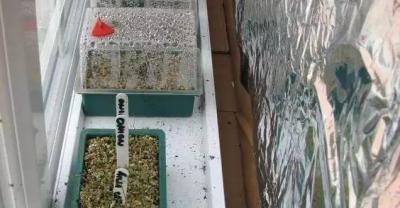Do you know how to tell the difference between acidity and basicity in the soil where flowers are grown?
People who have raised flowers and green plants should know that the soil is divided into acidity and alkalinity. In China, most of the northern regions are alkaline soils, while the southern regions are mostly acidic soils, and the suitable acidity and basicity of different plants are not the same. If the soil is not right, it will also be not conducive to the growth of flower green plants! But most of us probably don't know what plants are suitable for acidic soil and what plants are suitable for alkaline soil, and we don't know how to distinguish the acidity and basicity of the soil, so today the editor of Youju Network will give you an answer to these questions one by one.

First, how to identify the acidity and basicity of soil?
1. Look at the source of the soil. In nature, humus soil belongs to acid soil, rotten leaf soil in forest zone belongs to acid or slightly acid, peat soil and peat soil belongs to acid soil.
2. Look at the color and aggregates of the soil. Slightly acidic soils are generally black, brown, brownish black and yellowish red, while alkaline soils are mostly grayish white and yellowish white. Acid soil has more aggregate structure, while alkaline soil has little or no aggregate structure, most of them are sandy.
3. Look at the plants growing in the soil. Where legumes, sugar beets, sorghum, cotton, pears, grapes and other plants are planted in areas, generally neutral or alkaline soil; rich in wheat, sweet potato and other soil, mostly alkaline.
4. Look at the situation after watering. The soil is hardened and dries quickly after watering, and there will be a layer of white powdery physical soil on the surface. When watering, white bubbles or foams appear, mostly alkaline soil. After watering, the soil is soft, and even immediately oozes turbid water, mostly acidic soil.
5, by hand: the acid soil has a kind of "soft" feeling in the hand. After releasing the hand, the soil is easy to disperse, not easy to agglomerate, breathable and permeable; alkaline soil is hard and easy to agglomerate. Alkaline soil has a kind of "hard" feeling in the hand, and it is easy to agglomerate and not spread out after loosening the hand, and the ventilation and permeability is poor.
6. Test with pH test paper: soak part of the soil sample in cold boiled water, soak part of the test paper in the soaking solution, then take out the change of its color, and then compare the test paper with the colorimetric card, if the pH value is 7, the soil is neutral; if the pH value is < small, it is acidic; if the pH value > 7, it is alkaline.

What kind of flowers are suitable for planting in acidic soil and alkaline soil respectively?
Due to different places of origin, plants have different needs and adaptability to acidity and alkalinity. Most species of potted flowers are suitable for neutral to slightly acidic (PH5.5~7.0) soils. Flowers can be divided into the following categories according to their adaptation to soil acidity and alkalinity:
1. Acid-resistant flowers: there are (PH4~5) rhododendron, eight immortal flowers, gardenia, colored leaf grass, purple duckweed, ferns, orchids and so on.
2, suitable for weakly acidic flowers: there are (PH5~6) begonia, Zhu Dinghong, cyclamen, camellia, jasmine, Milan, Michelia, five-needle pine, palms, primroses, paulownia, Magnolia, sweet-scented osmanthus, etc.
3, suitable for neutral and acidic flowers: there are (PH6~7) chrysanthemum, asparagus, asparagus, poinsettia, rose, inverted golden bell, gentleman orchid, daffodil, bungee flower, pedicel begonia and so on.
4. Suitable for neutral and slightly alkaline flowers: (PH7~8) rose, carnation, geranium, Yingchun, yellow poplar, southern bamboo, elm leaf plum, juniper, hibiscus, pomegranate, grape, wisteria, cactus, sweet pea, blood grass and so on.

Third, how to change the pH of the soil?
1. When the acidity of the soil is too high, some lime powder or plant ash can be properly mixed into the flowerpot.
2. When the soil is too alkaline, we can often pour some diluted water of ferrous sulfate or aluminum sulfate to increase the acidity of the soil.
-I am the gorgeous dividing line-
Brand-name home improvement building materials from the 70% discount, the order will be reduced by 100 yuan, do not regret missing!
For more information, please follow the official Wechat of Tencent Home Youju (WeChat: youju2099)!
- Prev

A small method of self-made organic fertilizer, family flowers are indispensable, flowers keep blooming!
In fact, you don't need to buy fertilizer to grow flowers and vegetables at home, and you can also use ready-made garbage to make fertilizer. And it's very fertile and easy to use. The method.
- Next

Flower cultivation skills: the presbyopia teaches you how to distinguish between lotus and lotus!
The lotus is also known as the lotus. Is the lotus the lotus? Water lilies can also be called lotus flowers. What about lotus flowers? Is it a bit of a hoop? The warm home, the old gardener, the editor.
Related
- What if the leaves of potted flowers turn yellow?
- Florescence Control of several Flowers
- Anti-freezing technology and post-freezing nursing technology of flowers
- What is the classification of flowers? What are the common methods of flower classification?
- Prevention and control of alkali and acid damage of flowers in courtyard
- Technology of Anti-freezing and restoring growth of Flower seedlings in greenhouse and greenhouse
- How does flower fertilization not hurt the root? Fertilization technology of flowers
- Key points of disinfection in flower greenhouse
- Several pesticides that are banned or used cautiously in flowers
- How to fertilize the flowers that watch the leaves?

